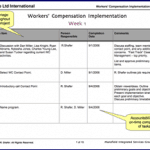Use these three links to scroll down to dozens of useful, categorized WC links or visit the Workers Comp Resource Center Reference Room just below. WC Resource Links Insurance & Risk Organization Links Safety, Health, & Wellness Links Workers Comp Resource Center Reference Room 50 State Laws & Regulations View current statutes and regulatory rules …
Phase 1: Assessment & Recommendation
Workers’ Comp Improvement Plan – Phase One Team Selection and Information Gathering Phase One – Steps 1 through 9 The steps in the Assessment & Recommendation Phase involve selecting a team and gathering information about your current program, including vendor partners, associated claims, and reported losses. STEP 1: ASSEMBLE PROJECT TEAM The Injury Management Planning …
Phase 2: Design & Development
Workers’ Comp Improvement Plan – Phase 2 Program Material Development Phase Two – Step 10 The steps in the Design & Development Phase involve developing all materials (templates, forms, sample letters, etc.) that will be used through the life of the program. STEP 10: DESIGN FORMS AND PROCEDURES Many forms will be designed during this …
Phase 3: Training & Implementation
Workers’ Comp Improvement Plan – Phase 3 All Employees from Top to Bottom Phase Three – Steps 11 through 13 The steps in the Training & Implementation Phase involve a training program for all employees from top management to individual workers who are involved in the workers’ compensation/injury management process. Employees will be up-to-date and …
Phase 4: Monitoring & Management
Phase Four – Step 14 The steps in the Monitoring & Management Phase involve posting implementation support and monitoring of processes, injury claims, and lost time data. STEP 14: MONITORING THE PROGRAM After implementation, the company should be able to demonstrate results through: Declining injury rates A shift in the Return to Work Ratio showing …
Reduce Wasteful Workers’ Comp Practices
Strive for Overall Cost Reduction With skyrocketing medical costs, employers must coordinate medical care more effectively. The best way to reduce medical costs is to return employees to their pre-injury health as quickly as possible, and that may mean spending more upfront to provide the best treatment possible. Although you must be familiar with all …
Select 3rd-Party Administrator
18 Key Considerations for Selecting a Third Party Administrator or Insurance Company to Control Your Workers’ Compensation Claims Selecting the best third-party administrator (TPA) is critical to controlling your workers’ compensation claims costs. Here are 18 things to consider when selecting a TPA. Key questions to ask prospective TPAs or include in your Request for …
Selection of Physical Therapy Providers
Doctors Usually Refer Employees to Physical Therapist An area often overlooked by employers and the workers compensation insurance adjusters is the proper selection of the physical therapist and office. Normally the orthopedic doctor tells the employee physical therapy is needed to avoid surgery or to recover from surgery. The employee says “Okay, who shall I …
Medicare Set-aside Arrangement Basics
We have received many questions about the Medicare Set-aside Arrangements (MSA) that are required by the Centers for Medicare and Medicaid Services (CMS). Here are the frequently asked questions on the basics of MSA, which we hope will provide you with more insight into the requirements of CMS. What is a MSA? A Medicare Set-Aside …
Improve Immediate Injury Response
Have procedures in place from the moment an injury occurs until an employee returns to work on full duty or transitional duty. Having procedures in place sends the message that you – the employer – are in control. Report the claim to your claim administrator immediately so the claims administrator can begin coordinating medical care …










